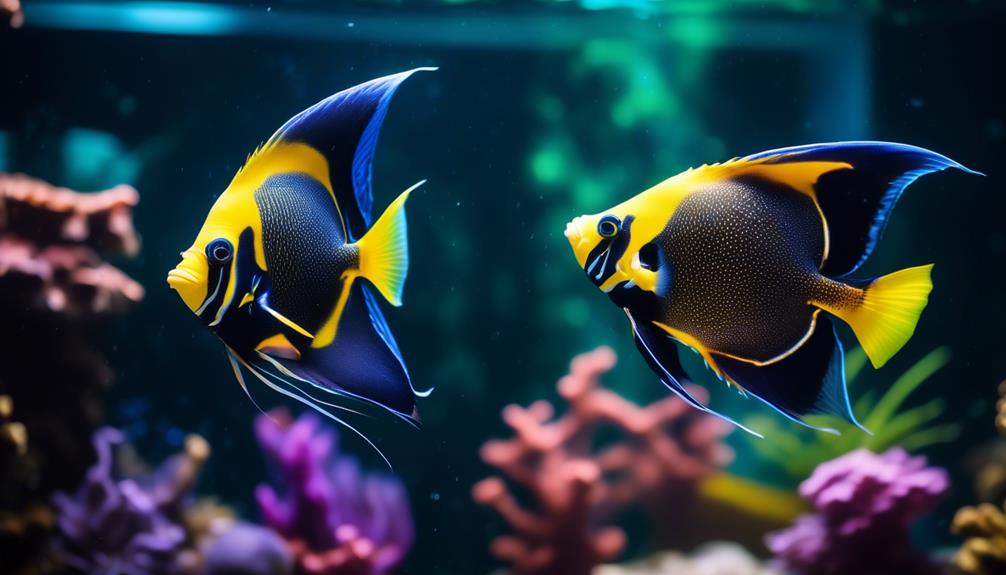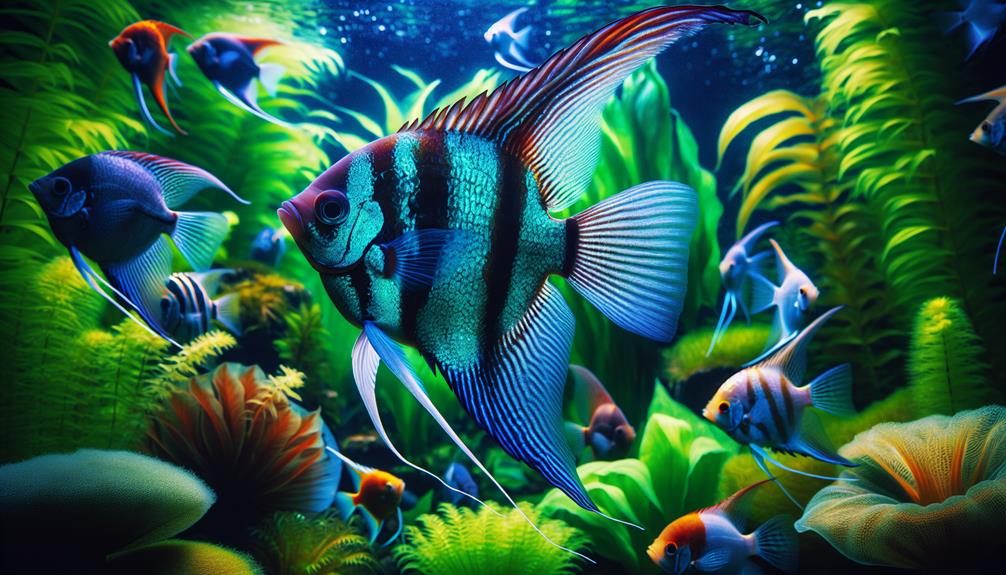Angelfish, with their dazzling colors and graceful movements, have long been admired as the stars of aquariums around the world. These captivating creatures, belonging to the Pterophyllum genus, are native to the freshwater rivers of South America.
With their unique characteristics and stunning varieties, from the silver elegance to the fiery zebra patterns, angelfish offer a mesmerizing spectacle in any tank. But there's more to them than just their beauty.
From their size and lifespan to their behavior and compatibility with other fish, there is a wealth of knowledge to uncover about these fiery stars.
So, let's dive into the fascinating world of angelfish and explore the secrets that lie beneath the surface.
Key Takeaways
- There are three species of angelfish: P. altum, P. leopoldi, and P. scalare.
- Angelfish can grow up to 6 inches in length and 8 inches in height, with P. altum being the largest species.
- With proper care, angelfish can live up to 8 to 12 years.
- Angelfish are relatively peaceful and can be kept in a community aquarium with compatible tank mates.
Angelfish Characteristics and Types
Angelfish cichlids, belonging to the Pterophyllum genus, are freshwater fish native to South America. These elegant fish are known for their beautiful color variations and interesting breeding habits. Angelfish come in a variety of colors, including silver, veil, koi, zebra, marble, albino, leopard, and platinum.
Their breeding habits are fascinating, with males competing for females and parents diligently protecting their eggs and fry. The different color variations add to the appeal of these fish, making them a popular choice for aquarium enthusiasts.
Understanding the breeding habits and color variations of angelfish can help fishkeepers create a suitable environment for these stunning creatures and encourage successful breeding.
Angelfish Size and Lifespan
Angelfish, popular freshwater fish from South America, display varying sizes and lifespans. To understand the growth rates and lifespan of angelfish, it is important to consider several factors:
- Size: Angelfish can grow up to 6 inches (15 cm) in body length and 8 inches (20 cm) in height. The largest species, P. altum, can reach lengths of 7 inches (18 cm) and heights of 10-13 inches (25-33 cm).
- Lifespan: With a clean environment and proper care, angelfish can live up to 8 to 12 years. However, size and lifespan can vary depending on the fish's environment and genetics.
- Factors influencing lifespan: Providing high-quality food and minimizing stress can help extend the lifespan of angelfish. Additionally, genetics and overall health play a significant role in determining their longevity.
- Angelfish growth rates: Angelfish grow at different rates depending on their species and individual genetics. It is important to provide them with a well-balanced diet and optimal water conditions to support their growth.
Understanding these factors can help angelfish owners create a suitable environment and provide the necessary care to ensure the longevity of their beloved aquatic pets.
Angelfish Behavior and Compatibility

The behavior and compatibility of angelfish in aquariums depend on their territorial nature and ability to live harmoniously with other fish.
Angelfish are known for their territorial behavior, particularly during breeding. Male angelfish compete for females, and once a pair is formed, they become protective parents, guarding their eggs and fry.
Compared to other cichlids, angelfish are relatively peaceful and can be kept in a community aquarium with compatible tank mates. However, it is important to avoid fin nippers or fast-swimming fish that may outcompete angelfish during feeding.
In order to ensure a harmonious tank environment, it is recommended to select tank mates that are compatible with angelfish and match their temperament and size.
Selecting Healthy Angelfish
When selecting healthy angelfish for your aquarium, it is important to look for specific characteristics that indicate their well-being. Here are four key indicators of angelfish health:
- Body Condition: Choose angelfish that have a meaty body and a thicker head. Avoid fish that appear overly thin or emaciated, as this may be a sign of poor health.
- Eye Health: Check for clear, bright eyes. Cloudy or damaged eyes can indicate an underlying health issue or poor water quality.
- Feeding Behavior: Select angelfish that are aggressive eaters. Observing their feeding habits at the store can give you insight into their overall health and vitality.
- Size: Opt for angelfish that are the size of a U.S. nickel, quarter, or half-dollar coin (0.8-1.2 inches or 2-3 cm). Smaller fish may be more susceptible to stress and disease.
Setting up an Angelfish Aquarium

To create an optimal environment for your angelfish, careful consideration must be given to the setup of your angelfish aquarium.
Firstly, it is important to choose the right tank mates for your angelfish. While angelfish are relatively peaceful, they can become territorial during breeding. It is best to avoid fin nippers or fast-swimming fish that may outcompete angelfish during feeding.
Secondly, creating a suitable environment for breeding is crucial. Angelfish prefer warmer temperatures between 78-86°F (25-30°C) and a pH range of 6.0 to 8.0, with closer to the middle being ideal. Additionally, adding beginner-friendly aquatic plants, like java fern, can enhance the aquarium and provide hiding spots for spawning.
Frequently Asked Questions
What Are Some Common Diseases or Health Issues That Angelfish May Experience?
Preventing and treating angelfish diseases is crucial for their well-being. Common health issues include bacterial and fungal infections, parasitic infestations, and swim bladder disorders. Compatible tank mates in a community setup include tetras, gouramis, and rasboras.
Can Angelfish Be Kept With Other Types of Cichlids in a Community Tank?
Yes, angelfish can be kept with other types of cichlids in a community tank. However, careful consideration of cichlid compatibility is necessary to ensure peaceful coexistence. Avoid aggressive or territorial species that may disrupt the harmony of the tank.
How Often Should Angelfish Be Fed and What Is the Recommended Diet?
Angelfish should be fed 2-3 times a day with a diet consisting of high-quality flake or pellet food. Supplement their diet with live or frozen foods like brine shrimp, bloodworms, and daphnia for optimal nutrition.
Are Angelfish Suitable for Beginner Fishkeepers?
Angelfish can be suitable for beginner fishkeepers, but there are pros and cons to consider. They have beautiful patterns and are relatively peaceful, but they require specific care and can be territorial. Proper research and tank setup are essential for success.
What Are Some Signs of Aggression or Territorial Behavior in Angelfish?
Signs of aggression and territorial behavior in angelfish include chasing, nipping, flaring fins, and aggressive displays. They may also become territorial during breeding, defending their eggs and fry. Monitoring their behavior and providing ample space can help mitigate aggression.
Conclusion
In conclusion, angelfish are captivating creatures that bring beauty and vibrancy to any aquarium. With their unique characteristics and stunning varieties, they are sure to be the fiery stars of your tank.
Understanding their size, lifespan, behavior, and compatibility is crucial for providing optimal care. By creating a suitable environment and selecting compatible tank mates, you can ensure the well-being of these peaceful yet territorial fish.
So dive into the world of angelfish and enjoy the mesmerizing presence they bring to your aquatic habitat.

